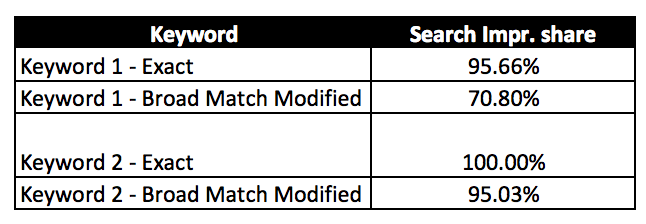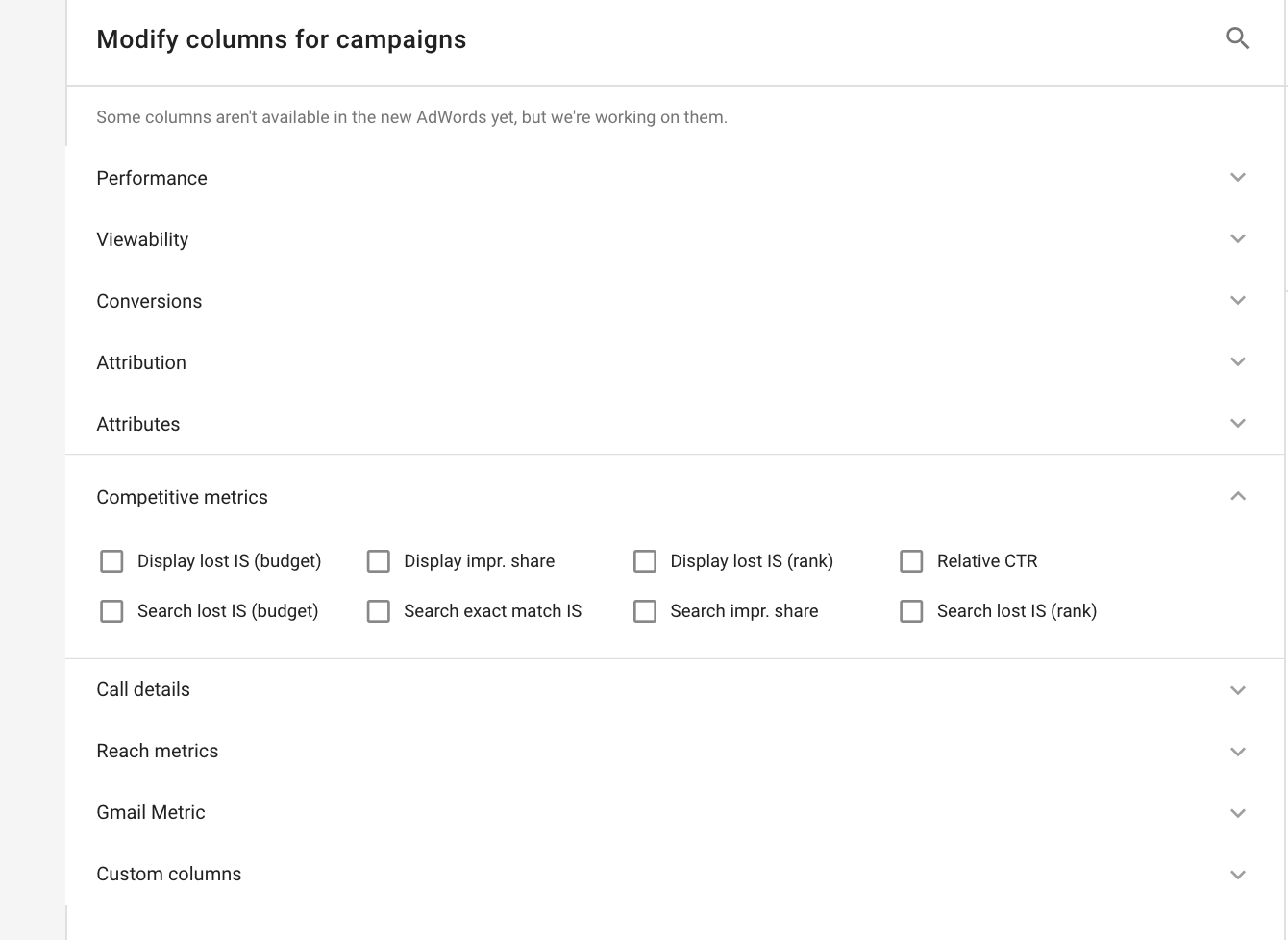As PPC experts, we live in a world of numbers and analysis. Particularly in AdWords, we are given a slew of metrics and expected to drive change as the numbers tell a story. This is great, as long as we know what the numbers are telling us and how to use them to their full potential.
Below, I’ll walk you through one underutilized metric; AdWords impression share. When thinking about impression share, it’s important to know these five things:
- What impression share is
- Why it’s important to you
- Where it’s located in your AdWords account
- How to read and measure it
- When there is opportunity to maximize impression share
What is impression share?
Impression share is simply the percentage of impressions that an ad received over the amount of impressions it could have actually received.

For example, a 33% impression share means that out of all the auctions you could have been shown, you were only included in about ⅓ of them. If you are the glass-half-empty type of person, that means you lost out on 67% of traffic.
As we get into the various metrics of impression share, we will see how it all fits together and why each metric is important.
Why impression share is important
At a high level, impression share is important because it paints a clear path of areas of opportunity for your ad to be served to more users.
Take the following for example:

Here we see impression share ranging from 70.8% to 100%. The higher your impression share, the more users you have reached out of the total number of users you were eligible to reach. An impression share of 70.8% indicates room for improvement and room for your ad to be served to more users, while an impression share of 100% indicates that your ad has been served to 100% of eligible users.
Levels of impression share & where it’s located within AdWords
When looking at impression share, it can be viewed at the following three levels. As a note, search and display impression share are calculated based on their respective network (search or display).
- Campaign: A high-level overview of where the campaign stands as a whole.
- Ad Group: More granular and focuses only on the ad copy and keywords contained in said ad group.
- Keyword: As granular as you can get and is a solid metric on how each keyword is performing.
At each level, the metrics can be pulled up by navigating to columns and modifying the columns to include impression share:


In the screenshot above, all impression share metrics are listed and can be viewed. While the definition in the introduction remains the same, two types of impression share exist — display and search. “Display” metrics can only be viewed with display campaigns and “Search” metrics can only be viewed with search campaigns.
- Display lost IS (budget): The percentage of times that your ad was not shown on the display network because your budget was too low.
- Display impr. share: Only on the display network.
- Display lost IS (rank): The percentage of times that your ad was not shown on the display network because your rank was too low.
- Relative CTR: How your display ad is performing in comparison to those on other sites.
- Search lost IS (budget): The percentage of times that your ad was not shown on the search network because your budget was too low.
- Search exact match IS: Your impression share for only exact match keywords. Note: It should be higher than that of all keywords.
- Search impr. share: Only on the search network.
- Search lost IS (rank): The percentage of times that your ad was not shown on the search network because your rank was too low.
How to read and measure AdWords impression share
From the impression share equation shown at the beginning of the article let’s analyze in more detail what goes into that. When an auction happens a number of factors go into play:
- Bids and targeting
- Ad status: Approved, limited approval, disapproved
- Quality score
Knowing this, we can make some educated decisions on how to measure impression share. The following KPIs are the first places you should analyze in order to optimize impression share.
- Average Position: This is an easy way to catch some low hanging fruit. A high average position indicates that there is room to move up on the SERP for your ad to be viewed more often. A low average position indicates that you may not be able to move up on the SERP but other areas may need improvement.
- Quality Score: Lower quality scores indicate that ad copy and post-click landing page relevance are areas that could be improved. By working to improve these areas, it will impact your quality score and allow your ads to rank higher in auctions.
- Targeting: Is there specific targeting that doesn’t match up with your consumer? Analyzing performance across all targeting can allow you to pull back in areas that aren’t efficient and focus on those that do drive leads and sales.
3 opportunities to maximize impression share
After conducting all of your analysis, there are several ways to increase impression share steadily. Below are some routes that I have taken in the past but at the end of the day, every account is different.
- One-off bid adjustments or automated bid adjustments can do wonders. To increase impression share, I have set automated rules for a specific amount of time. Automated rules can focus on average position, top of the page bid rules, etc. This assists in auctions to increase overall average position, therefore, also having an impact on impression share.
- Ad testing is another way to boost quality score and influence impression share. The act of rotating ad copy has proved to affect overall performance but also allows for advertisers to gain insight into the language that drives higher conversions. With this, you are working towards improving quality score, which assists with quality score and thus, impression share.
- Target your audience by ensuring that all targeting is segmented to view results (referred to as “bid only”) because that allows for optimizations in the future. For example, by “targeting” various audiences or interests, you can simply see how many users fall into a specific target. From that point, you can make decisions to pull back or push in inefficient or efficient areas.
Impressions are great, but then what?
In summary, impression share is a valuable metric that will allow you to determine areas in your account that need improvement and are eligible to receive more impressions. When optimized and taken seriously, it can help you boost overall traffic and thus, site engagement. While boosting impression share may not turn performance upside down, it’s a great starting point.
Of course, bids, targeting, and Quality Score are essential first steps in getting your ads shown in SERP. The next phase is writing persuasive copy to encourage search users to click — the pre-click stage. But you can’t forget about the post-click optimization stage because it’s just as important as any other in the process. See how Instapage can turn more of your ad clicks into conversions. Sign up for an Instapage Enterprise demo today.
About the author
Shannon Glass is an Account Manager at Hanapin Marketing, where she manages eCommerce and Lead Gen accounts. She has been there for over three years, where she initially began her PPC career as a Production Specialist. Aside from managing accounts, she writes for PPCHero, Hanapin’s blog, and assists with additional content for Hanapin. She enjoys traveling all over the world and taste testing new food.

See the Instapage Enterprise Plan in Action.
Demo includes AdMap™, Personalization, AMP,
Global Blocks, heatmaps & more.
